Multi-Stakeholder Development of a Serious Game to Explore the Water-Energy-Food-Land-Climate Nexus: The SIM4NEXUS Approach
Abstract
:1. Introduction
2. Serious Game Development: Process Overview
2.1. Case Study System Conceptualisation and Data Identification (Steps 1 and 2)
2.2. System Quantification: System Dynamics Modelling (Step 3)
2.3. Knowledge Elicitation Engine (Step 4)
- (1)
- WatERP ontology [44], developed under the EC FP7 project ‘WatERP’ (see HTTP://WWW.WATERP-FP7.ORG/ for a general project description), which reflects the water manager’s expertise for managing water supply and demand. The novelty of the WatERP ontology lies in including interactions with natural processes as a mechanism to understanding how to affect changes in water resources management so as to achieve the objective of matching supply with demand. These interactions could range from infrastructures to management decisions.
- (2)
- The WEFNexus ontology [45], which concerns water, energy and food derived from the European Directives: Article 2 of EU Directive 98/83/EC that defines the water intended for human consumption; Article 2 of EU Directive 2003/30/EC that defines bio-fuels; and Article 2 of EU Regulation 178/2002/EC that defines food.
2.4. Serious Game Front-End (Step 5)
- (i)
- Key indicators across all nexus components. These key indicators will be defined with case study partners to ensure the game is suitably targeted for the local context. Local stakeholder meetings will be used to elucidate these indicators.
- (ii)
- Events within the game. Events are news happening “on the ground”, which add a societal and cultural aspect to the game. These events will be narrated in the same tone as the shared socioeconomic pathways (SSPs; [48]) and will be triggered based on the decisions the player made in the game. There will be uncertainties in event triggers to add more realism in the game (e.g., the occurrence of extreme events such as economic crisis or disaster events). There will be three categories of events: (a) informational events, which are neutral; (b) negative events, which will penalize the player by deducting points; and (c) positive events, which will reward the player with bonus points.
- (iii)
- Score. There will be a score for the player. The score will indicate how successful the player is at applying nexus-compliant decision making to achieve the targets in the game. Every progression in the time-step of the game will add to the score to encourage the player to continue, with every policy implemented and events occurring adding further points to this score. The score is computed as follows:where:
- the score S is based on a weighted sum of squared, normalized, differences between indicators xi and targets gi;
- the x0i stands for the starting value of the indicator at the beginning of the game;
- for indicators that must be maximized mi = 1, and for indicators that must be minimized mi = −1;
- the sum of the weights ∑iwi = 1;
- S = 1 is the maximal score to be attained (full compliance with all targets).
3. Results from the Sardinia Fast-Track
4. Lessons Learned and Future Developments in SIM4NEXUS
- (1)
- Collaborative and constructive stakeholder involvement from project inception is critical in the development of meaningful models and games that are more likely to have impact. Suitable policy analysis is an important aspect in appropriate case study framing and model/game design and;
- (2)
- Appropriate spatial scale selection for the case study and nexus sectors is important in producing reliable model outputs. Deciding on the spatial scale and potential disaggregation of a case study is intimately linked to Lesson 1 above.
Acknowledgments
Author Contributions
Conflicts of Interest
References
- World Economic Forum. The Global Risks Report 2016, 11th ed.; World Economic Forum: Cologny, Switzerland, 2016; p. 103. Available online: http://wef.ch/risks2016 (accessed on 18 January 2016).
- Hoff, H. Understanding the Nexus; Background paper for the Bonn2011 Conference: The Water, Energy and Food Security Nexus; Stockholm Environment Institute: Stockholm, Sweden, 2011; p. 52. Available online: https://www.sei-international.org/publications?pid=1977 (accessed on 17 June 2017).
- WWF (World Wide Fund for Nature) & SABMiller. The Water-Food-Energy Nexus; Insights into Resilient Development; WWF (World Wide Fund for Nature): Gland, Switzerland; SABMiller: London, UK, 2014; p. 20. Available online: http://assets.wwf.org.uk/downloads/sab03_01_sab_wwf_project_nexus_final.pdf (accessed on 3 August 2014).
- Sušnik, J. Economic metrics to estimate current and future resource use, with a focus on water withdrawals. Sustain. Prod. Consum. 2015, 2, 109–127. [Google Scholar] [CrossRef]
- WWAP (World Water Assessment Programme). The United Nations World Water Development Report 2015: Water for a Sustainable World; UNESCO: Paris, France, 2015; p. 139. Available online: http://www.unesco.org/new/en/natural-sciences/environment/water/wwap/wwdr/2015-water-for-a-sustainable-world/ (accessed on 2 February 2017).
- Fasel, M.; Brethaut, C.; Rouholahnejad, E.; Lacayo-Emery, M.A.; Lehmann, A. Blue water scarcity in the Black Sea catchment: Identifying key actors in the water-ecosystem-energy-food nexus. Environ. Sci. Policy 2016, 66, 140–150. [Google Scholar] [CrossRef]
- Feng, M.; Liu, P.; Li, Z.; Zhang, J.; Liu, D.; Xiong, L. Modelling the nexus across water supply, power generation and environment systems using the system dynamics approach: Hehuang Region, China. J. Hydrol. 2016. [Google Scholar] [CrossRef]
- World Bank. High and Dry: Climate Change, Water and the Economy; World Bank: Washington, DC, USA, 2016; p. 69. [Google Scholar]
- Sušnik, J.; van der Zaag, P. Correlation and causation between the UN Human Development Index and national and personal wealth and resource exploitation. Econ. Res. (Ekonomska Istraživanja) 2017, 30, 1705–1723. [Google Scholar] [CrossRef]
- Najibi, N.; Devineni, N.; Lu, M. Hydroclimatic drivers and atmospheric teleconnections of long duration floods: An application to large reservoirs in the Missouri River Basin. Adv. Water Res. 2017, 100, 153–167. [Google Scholar] [CrossRef]
- IMechE (Institute of Mechanical Engineers). Global Food: Waste Not, Want Not; IMechE: London, UK, 2013; p. 35. [Google Scholar]
- EEA (European Environment Agency). European Environment—State and Outlook 2015: Assessment of Global Megatrends; European Environment Agency: Copenhagen, Denmark, 2015; p. 140. [Google Scholar] [CrossRef]
- OECD. The Land-Water-Energy Nexus: Biophysical and Economic Consequences; OECD Publishing: Paris, France, 2017. [Google Scholar] [CrossRef]
- Brouwer, F.; Avgerinopoulos, G.; Fazekas, D.; Laspidou, C.; Mercure, J.-F.; Pollitt, H.; Ramos, E.P.; Howells, M. Energy modelling and the Nexus concept. Energy Strateg. Rev. 2017. [Google Scholar] [CrossRef]
- Simonovic, S.P. World water dynamics: Global modelling of water resources. J. Environ. Manag. 2002, 66, 249–267. [Google Scholar] [CrossRef]
- Hussein, W.A.; Memon, F.A.; Savić, D.A. An integrated model to evaluate water-energy-food nexus at a household scale. Environ. Model. Softw. 2017, 93, 366–380. [Google Scholar] [CrossRef]
- Valek, A.M.; Sušnik, J.; Grafakos, S. Quantification of the urban water-energy nexus in México City, México, with an assessment of water-system related carbon emissions. Sci. Total Environ. 2017, 590, 258–268. [Google Scholar] [CrossRef] [PubMed]
- Small, G.; Vorgan, G. Meet your iBrain. Sci. Am. Mind 2008, 19, 42–49. [Google Scholar] [CrossRef]
- Gee, J.P. What video games have to teach us about learning and literacy. In Theoretical and Practical Computer Applications in Entertainment; ACM: New York, NY, USA, 2003; Volume 1, p. 20. [Google Scholar] [CrossRef]
- Mayer, I.S. The gaming of policy and the politics of gaming: A review. Simul. Gaming 2009, 40, 825–862. [Google Scholar] [CrossRef]
- Savić, D.A.; Morley, M.S.; Khoury, M. Serious Gaming for Water Systems Planning and Management. Water 2016, 8, 456. [Google Scholar] [CrossRef]
- Salen, K.; Zimmerman, E. Rules of Play: Game Design Fundamentals; The MIT Press: Cambridge, MA, USA; London, UK, 2004; p. 668. [Google Scholar]
- Abt, C.C. Serious Games; Viking: New York, NY, USA, 1970. [Google Scholar]
- Van der Graaf, J.; Segers, E.; Verhoeven, L. Discovering the laws of physics with a serious game in kindergarten. Comput. Educ. 2016, 101, 168–178. [Google Scholar] [CrossRef]
- Gugerell, K.; Zuidema, C. Gaming for the energy transition: Experimenting and learning in co-designing a serious game prototype. J. Clean. Prod. 2017, 169, 105–116. [Google Scholar] [CrossRef]
- Kang, J.; Liu, M.; Qu, W. Using gameplay data to examine learning behaviour patterns in a serious game. Comput. Hum. Behav. 2017, 72, 757–770. [Google Scholar] [CrossRef]
- Planchon, J.; Vacher, V.; Comblet, J.; Rabatel, E.; Darses, F.; Mignon, A.; Pasquier, P. Serious game training improves performance in combat life-saving situations. Injury 2017, 49, 86–92. [Google Scholar] [CrossRef] [PubMed]
- Tan, A.J.Q.; Lee, C.C.S.; Lin, P.Y.; Cooper, S.; Lau, L.S.T.; Chua, W.L.; Liaw, S.Y. Designing and evaluating the effectiveness of a serious game for safe administration of blood transfusion: A randomized controlled trial. Nurse Educ. Today 2017, 55, 38–44. [Google Scholar] [CrossRef] [PubMed]
- Van der Wal, M.M.; de Kraker, J.; Kroeze, C.; Kirschner, P.A.; Valkering, P. Can computer models be used for social learning? A serious game in water management. Environ. Model. Softw. 2016, 75, 119–132. [Google Scholar] [CrossRef]
- Medema, W.; Furber, A.; Adamowski, J.; Zhou, Q.; Mayer, I. Exploring the Potential Impact of Serious Games on Social Learning and Stakeholder Collaborations for Transboundary Watershed Management of the St. Lawrence River Basin. Water 2016, 8, 175. [Google Scholar] [CrossRef]
- Gurung, T.R.; Bousquet, F.; Trebuil, G. Companion modelling, conflict resolution, and institution building: Sharing irrigation water in the Lingmuteychu watershed, Bhutan. Ecol. Soc. 2006, 11, 36. [Google Scholar] [CrossRef]
- Hagen, E. New approaches in the Potomac river basin and beyond—Pioneering work in the development of shared vision planning. In Converging Waters: Integrating Collaborative Modeling with Participatory Processes to Make Water Resources Decisions; Bourget, E., Ed.; Institute for Water Resources, U.S. Army Corps of Engineers: Alexandria, VA, USA, 2011; pp. 35–58. [Google Scholar]
- Mereu, S.; Sušnik, J.; Trabucco, A.; Daccache, A.; Vamvakeridou-Lyroudia, L.; Renoldi, S.; Virdis, A.; Savić, D.A.; Assimacopoulos, D. Operational resilience of reservoirs to climate change, agricultural demand, and tourism: A case study from Sardinia. Sci. Total Environ. 2015, 543, 1028–1038. [Google Scholar] [CrossRef] [PubMed] [Green Version]
- Britz, W.; Witzke, H.P. CAPRI Model Documentation; Institute for Food and Resource Economics University of Bonn: Bonn, Germany, 2014. [Google Scholar]
- Cambridge Econometrics. E3ME Technical Manual Version 6; Cambridge Econometrics: Cambridge, UK, 2014; p. 136. Available online: www.camecon.com/how/e3me-model/ (accessed on 12 November 2017).
- Hempel, S.; Frieler, K.; Warszawski, L.; Schewe, J.; Piontek, F. A trend preserving bias correction—the ISI-MIP approach. Earth Syst. Dyn. 2013, 4, 219–236. [Google Scholar] [CrossRef]
- Van Vuuren, D.P.; Edmonds, J.; Kainuma, M.; Riahi, K.; Thomson, A.; Hibbard, K.; Hurtt, G.C.; Kram, T.; Krey, V.; Lamarque, J.F.; et al. The representative concentration pathways: An overview. Clim. Chang. 2011, 109, 5–31. [Google Scholar] [CrossRef]
- Ford, A. Modeling the Environment. In An Introduction to System Dynamics Modeling of Environmental Systems; Island Press: Washington, DC, USA, 1999; p. 401. [Google Scholar]
- Rehan, R.; Knight, M.A.; Haas, C.T.; Unger, A.J.A. Application of system dynamics for developing financially self-sustaining management policies for water and wastewater systems. Water Res. 2011, 45, 4737–4750. [Google Scholar] [CrossRef] [PubMed]
- Sahin, O.; Siems, R.S.; Stewart, R.A.; Porter, M.G. Paradigm shift to enhanced water supply planning through augmented grids, scarcity pricing and adaptive factory water: A system dynamics approach. Environ. Model. Softw. 2014, 75, 348–361. [Google Scholar] [CrossRef]
- Sušnik, J.; Vamvakeridou-Lyroudia, L.S.; Savić, D.A.; Kapelan, Z. Integrated modelling of a coupled water-agricultural system using system dynamics. J. Water Clim. Chang. 2013, 4, 209–231. [Google Scholar] [CrossRef]
- Tidwell, V.C.; Passell, H.D.; Conrad, S.H.; Thomas, R.P. System dynamics modeling for community-based water planning: Application to the Middle Rio Grande. Aquat. Sci. 2004, 66, 357–372. [Google Scholar] [CrossRef]
- Mieczkowski, Z. The Tourism Climatic Index: A Method of Evaluating World Climates for Tourism. Can. Geogr. 1985, 29, 220–233. [Google Scholar] [CrossRef]
- Anzaldi, G. Generic Ontology for Water Supply Distribution Chain; Eurecat Technology Center: Barcelona, Spain, 2015; Available online: http://waterp-fp7.eu/Downloads/deliverables/D1.3_Generic_Ontology_for_water_supply_distribution_chain_v1.3.pdf (accessed on 15 December 2017).
- WEFNexus Ontology. Available online: https://github.com/mizanur3/WEFNexus (accessed on 15 December 2017).
- OGC (Open Geospatial Consortium). OGC® WPS 2.0 Interface Standard; Open Geospatial Consortium: Wayland, MA, USA, 2015; Available online: http://www.opengeospatial.org/standards/wps (accessed on 15 December 2017).
- Chew, C.; Lloyd, G.J.; Knudsen, E. Capacity building in water with serious games. In Subconscious Learning via Games and Social Media; Sourina, O., Wortley, D., Kim, S., Eds.; Springer: Singapore, 2015; pp. 27–43. [Google Scholar]
- O’Neill, B.C.; Kriegler, E.; Ebi, K.L.; Kemp-Benedict, E.; Riahi, K.; Rothman, D.S.; van Ruijven, B.J.; van Vuuren, D.P.; Birkmann, J.; Kok, K.; et al. The roads ahead: Narratives for shared socioeconomic pathways describing world futures in the 21st century. Glob. Environ. Chang. 2015, 42, 169–180. [Google Scholar] [CrossRef]
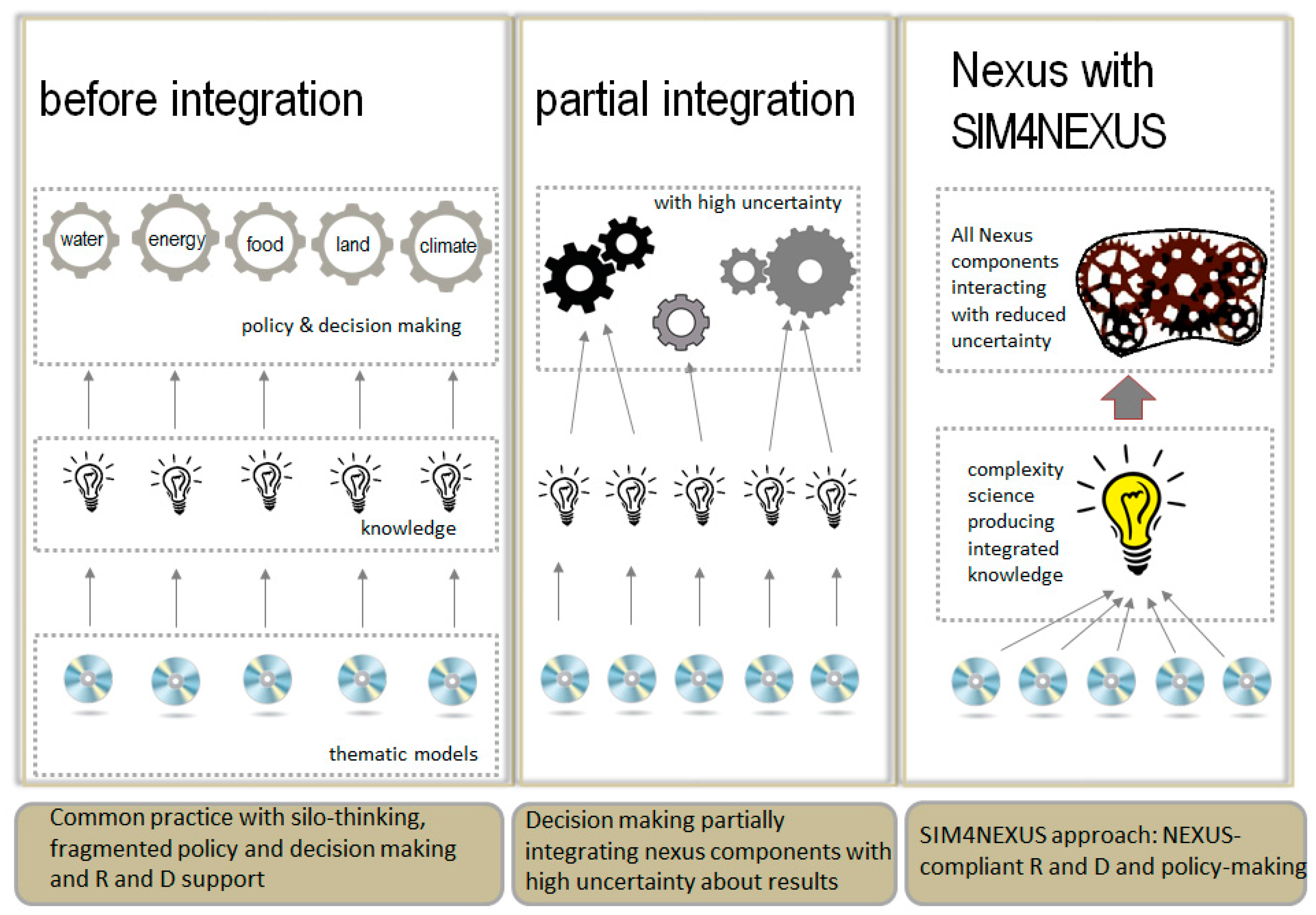


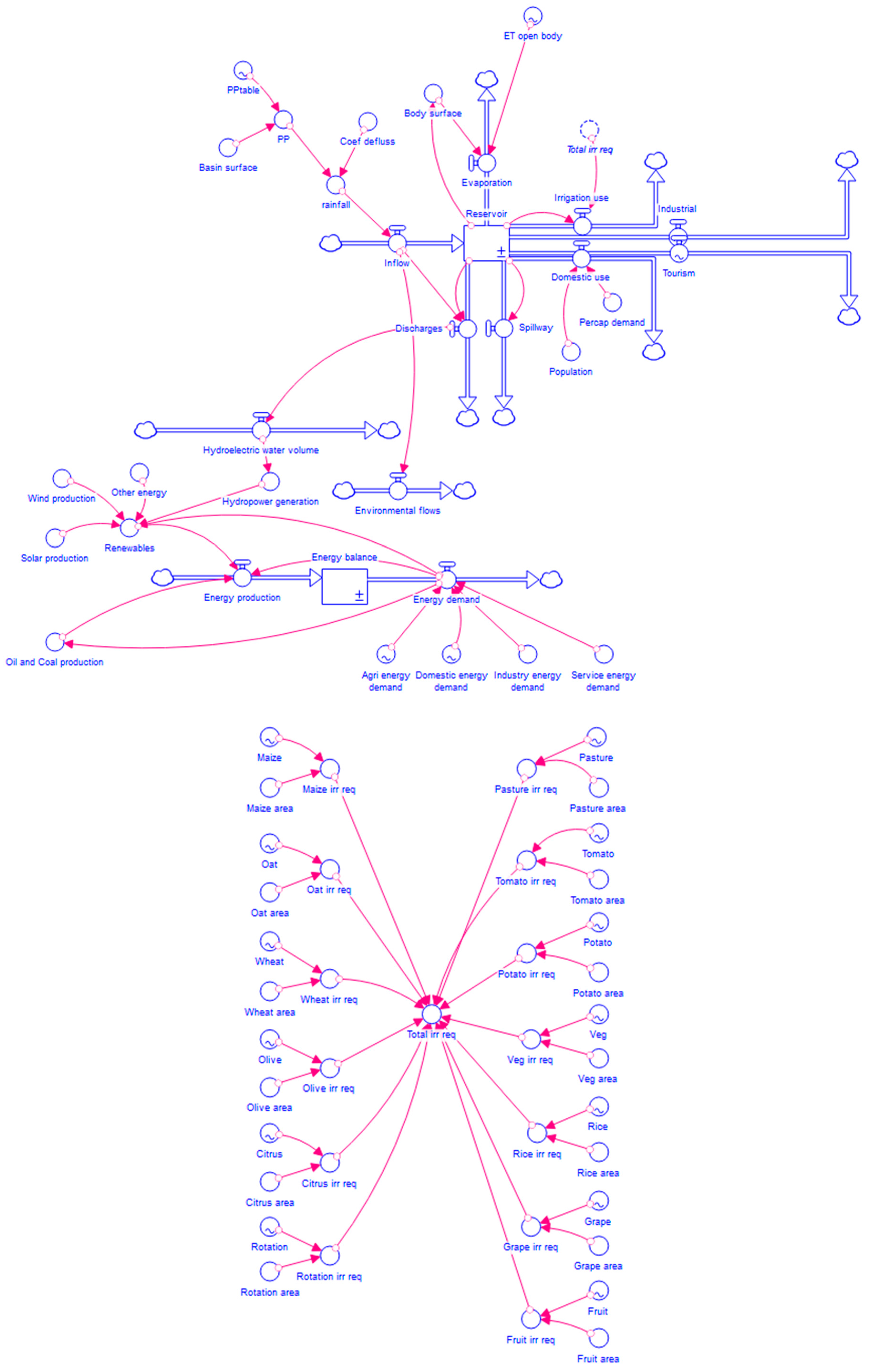
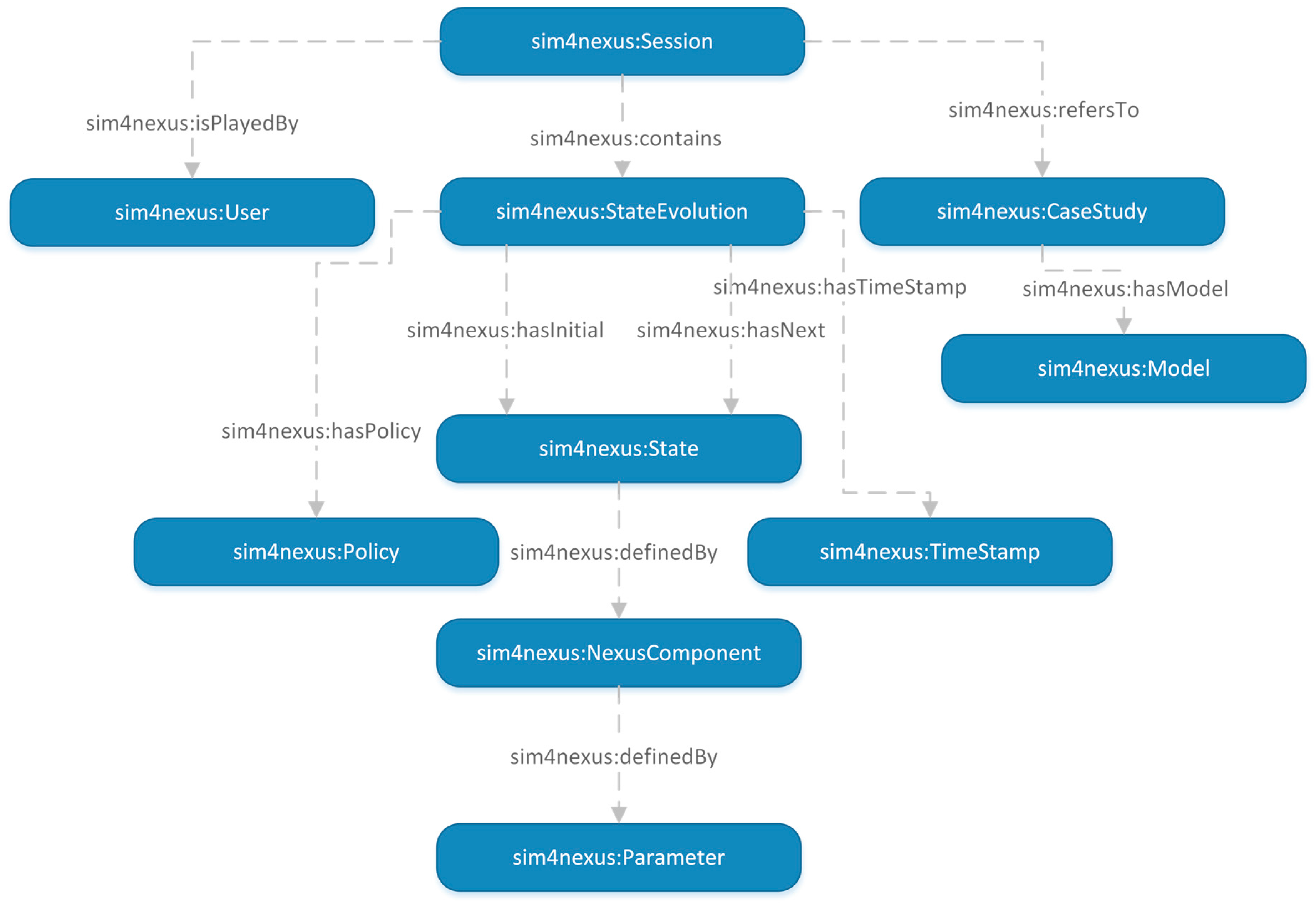
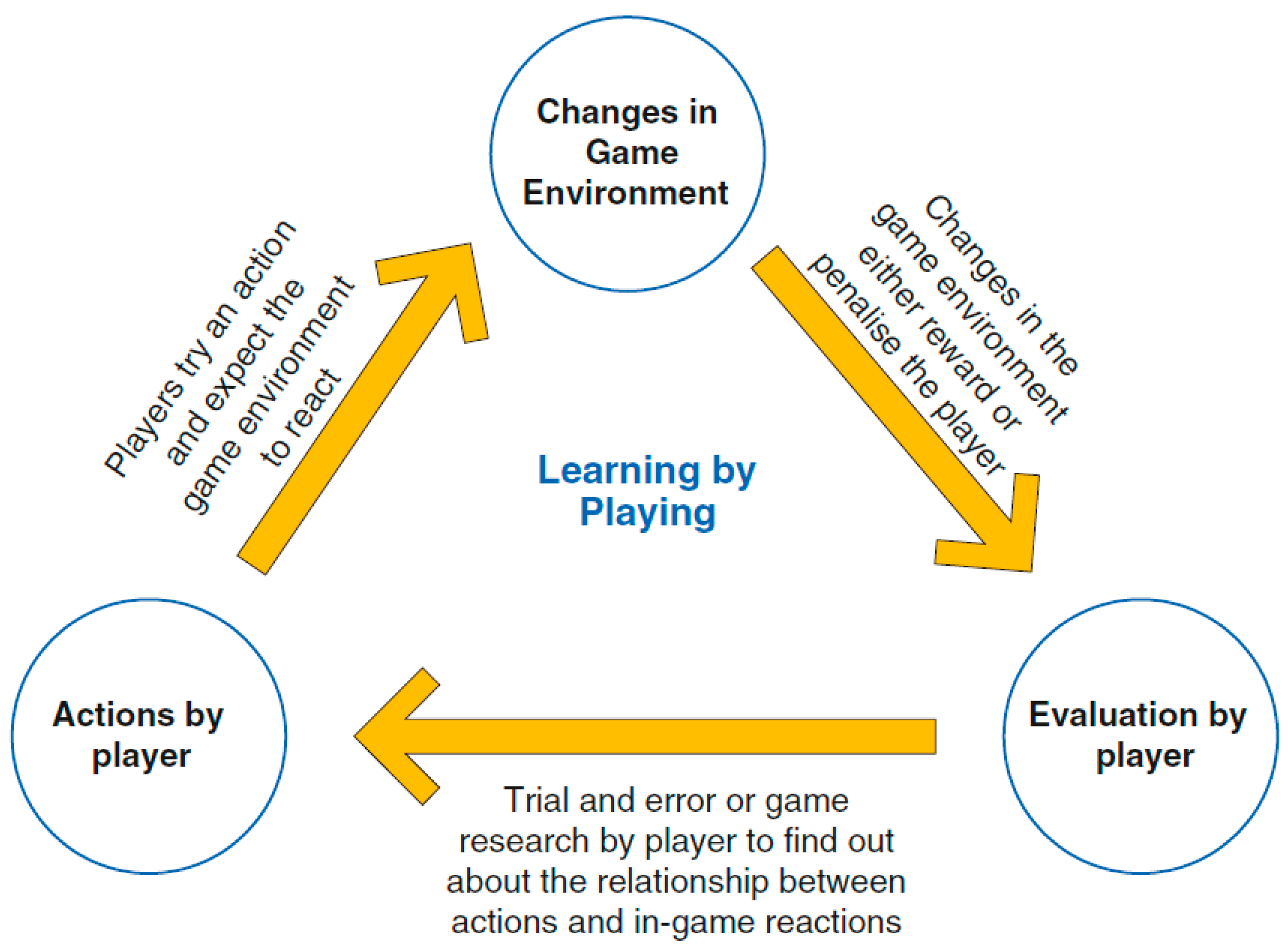
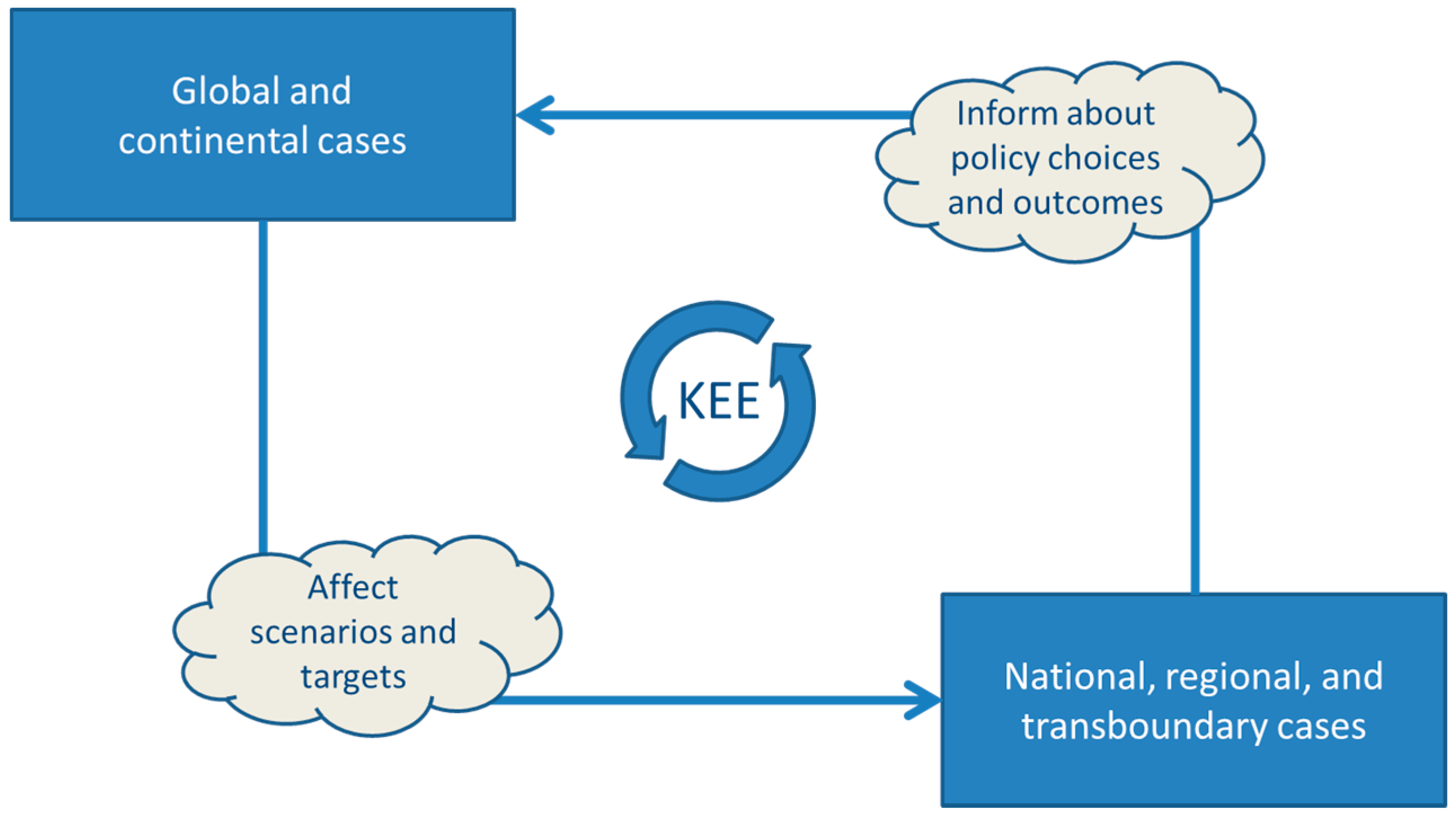

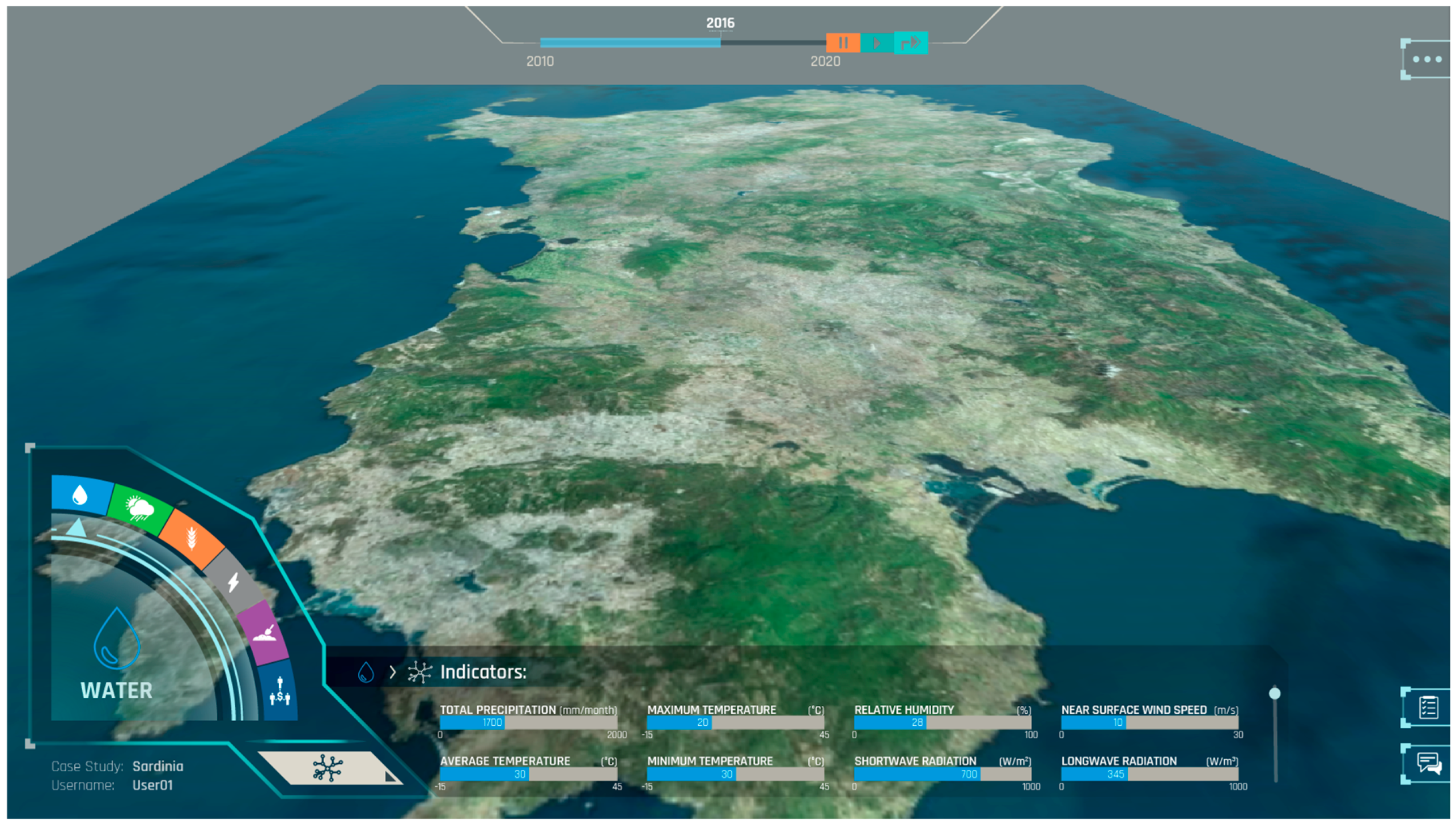
| File | Purpose |
|---|---|
| R Function File | Contains details relating to time-series lookup tables used by the main script along with mathematical functions |
| Time-Series Files | Input data within the STELLA model are stored as time-series CSV files that are referenced within the R function file |
| Coefficient Files | A coefficient file is generated for each time-series variable to allow for policy implementation at a monthly scale, e.g., specific crop area can be reduced by 20% from June to August by switching the coefficient variable from 1.0 to 0.8 for those months. |
| Dynamic Variable Equations | Values within the SDM that change over time and/or are dependent on conditions of other dynamic variables are stored as a reference so that these lines can be substituted by variations of that line to allow for policy changes to be implemented |
| Case | Rule |
|---|---|
| 1 | If water in the reservoir is above 20% of the reservoir capacity, then 10% of the monthly basin run-off is allowed to be environmental flow. |
| 2 | If water in the reservoir is below 20% of the reservoir capacity, then 5% of the monthly basin run-off is allowed to be environmental flow. |
| 3 | If water in the reservoir is below 10% of the reservoir capacity, then 0% of the monthly basin run-off is allowed to be environmental flow. |
© 2018 by the authors. Licensee MDPI, Basel, Switzerland. This article is an open access article distributed under the terms and conditions of the Creative Commons Attribution (CC BY) license (http://creativecommons.org/licenses/by/4.0/).
Share and Cite
Sušnik, J.; Chew, C.; Domingo, X.; Mereu, S.; Trabucco, A.; Evans, B.; Vamvakeridou-Lyroudia, L.; Savić, D.A.; Laspidou, C.; Brouwer, F. Multi-Stakeholder Development of a Serious Game to Explore the Water-Energy-Food-Land-Climate Nexus: The SIM4NEXUS Approach. Water 2018, 10, 139. https://doi.org/10.3390/w10020139
Sušnik J, Chew C, Domingo X, Mereu S, Trabucco A, Evans B, Vamvakeridou-Lyroudia L, Savić DA, Laspidou C, Brouwer F. Multi-Stakeholder Development of a Serious Game to Explore the Water-Energy-Food-Land-Climate Nexus: The SIM4NEXUS Approach. Water. 2018; 10(2):139. https://doi.org/10.3390/w10020139
Chicago/Turabian StyleSušnik, Janez, Chengzi Chew, Xavier Domingo, Simone Mereu, Antonio Trabucco, Barry Evans, Lydia Vamvakeridou-Lyroudia, Dragan A. Savić, Chrysi Laspidou, and Floor Brouwer. 2018. "Multi-Stakeholder Development of a Serious Game to Explore the Water-Energy-Food-Land-Climate Nexus: The SIM4NEXUS Approach" Water 10, no. 2: 139. https://doi.org/10.3390/w10020139






